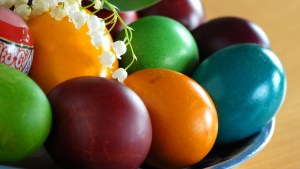Lenten Campaign 2025
This content is free of charge, as are all our articles.
Support us with a donation that is tax-deductible and enable us to continue to reach millions of readers.
The traditional Ukrainian Easter egg, the pysanka, are brilliantly designed and vibrant in their multi-colored majesty. One single pysanka can take hours to complete, but the results can be as beautiful as a Faberge egg.
In times of peace, Ukrainians normally spend the last week of Lent creating these works of art. As millions of people have had to flee their country following the Russian invasion of their country, the tradition of decorating eggs, is for many Ukrainians, yet another cherished ritual the they have had to sacrifice.
This Easter, people all over the world, in solidarity with Ukraine, will introduce the tradition of pysanka into their own homes this Easter. The beautiful eggs serve as reminder to all of hope that comes from the ultimate sacrifice, that of Christ on the Cross.
The word pysanka is rooted in a verb that means “to write” and it is fitting, as the egg is written on to make the design. Traditionally, the woman of the house would make the pysanky while the children slept. The lines were drawn while saying prayers for the loved ones to whome the egg was intended, and each line bore an intention.
In this way this contemplative practice is similar to the Holy Rosary and the making of pysanky can become a devotion that can show solidarty with Ukraine. We encourage the artistically inclined among us to mindfully write their own Pysanka for those who cannot write their own. As for what to pray while you write, Pope Francis supplied us with a prayer for Ukraine on Ash Wednesday:
Lord God of peace, hear our prayer!
Open our eyes and our hearts,
and give us the courage to say:
“Never again war!”;
“With war everything is lost.”
Instill in our hearts the courage
to take concrete steps to achieve peace.
Keep alive within us the flame of hope,
so that with patience and perseverance
we may opt for dialogue and reconciliation.
In this way may peace triumph at last.
Amen.
The process
The process begins by penciling a design on the egg, which is traditionally broken up into 16 sections. These lines are then redrawn with beeswax, using a specialized tool called a kystka. This stylus is equipped with a reservoir and a funnel for holding and applying the wax.
The wax protects the color underneath, allowing the artist to dip the egg into multiple colors without sacrificing any of the previous work. The pysanka becomes more and more intricate as it progresses, with more lines drawn after each dipping. Each of the additions will bear a different color by the end of the work.
The colors are applied from light to dark, with the eggshell’s white remaining the lightest, and usually a dark red or black as a finish. The color red bears a Christian significance in pysanky writing, representing the divine love and passion of Christ, hope, fire, and the ministry of the church.
The darker colors accentuate the lighter ones, which remain clear to see after the beeswax is removed. One of the best parts of pysanky is that the shell is emptied, so that the work of art can remain for years to come.
Make your own
In the video below, artist Larissa Poho takes viewers through a pysanka writing. Poho gives a succinct rundown of all the materials and tools needed, while making one herself. Her laid back demeanor helps viewers gain confidence for what can seem like a daunting task. She even makes a few mistakes herself in order to show the viewers that it’s not the end of the world.


